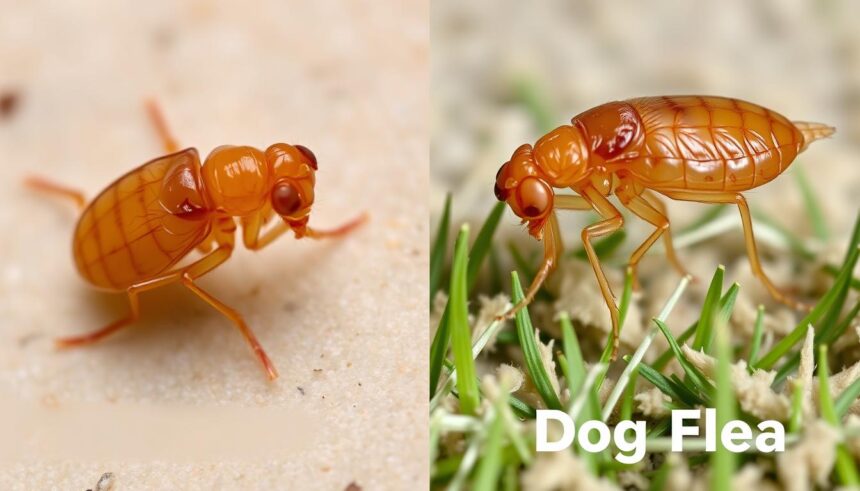As a pet owner, you might wonder if cat and dog fleas are the same. The answer is no, but they share some similarities. Cat fleas are the most common in the United States. If your dog or cat has fleas, it’s likely they are cat fleas, with a 90% chance.
It’s important to know the differences and similarities between cat and dog fleas. This knowledge helps in preventing and treating infestations. Cat fleas can infest both cats and dogs, while dog fleas mainly prefer dogs. Understanding each type helps protect your pets and home.
Cat and dog fleas can jump up to 7 inches vertically. This lets them easily reach human feet and ankles. They thrive in warm, humid environments, making them a problem all year in many places.
Key Takeaways
- Are cat and dog fleas the same? No, they are different species, but they share some similarities between cat and dog fleas.
- Cat fleas are the most common flea species found in the United States.
- Dog fleas tend to prefer dogs as their primary host, while cat fleas can infest both cats and dogs.
- Understanding the differences and similarities between cat and dog fleas is crucial for effective prevention and treatment.
- Regular checks for signs of fleas, use of flea preventative products, and frequent washing of pet bedding in hot water can help manage infestations.
- Prompt veterinary care is essential if fleas are detected to prevent an infestation from worsening.
- Effective prevention includes treating all pets in a household simultaneously to avoid reinfestation among them.
Introduction to Fleas
Fleas are a big problem for pet owners. Knowing how they behave and live is key to controlling them. Many wonder are cat and dog fleas the same. The answer is no. Each type of flea has its own way of living, where it likes to be, and how to treat it.
The differences in cat and dog flea treatment are big. Pet owners need to know these differences to fight flea infestations well. For instance, cat fleas are more common. They can live on cats, dogs, and even people.
- Fleas can jump up to 13 inches vertically and 8 inches horizontally compared to their size.
- The flea life cycle has four stages: egg, larva, pupa, and adult.
- Fleas can grow up in as little as 14 days in good conditions. But, it can take months in bad conditions.
By learning about flea behavior and life cycle, pet owners can stop and control flea problems. This helps keep pets and people safe from flea-borne diseases.
Types of Fleas Common in Pets
Many flea species can affect pets, like cats and dogs. Knowing the differences between cat and dog fleas is key for keeping pets healthy. This knowledge helps pet owners choose the best flea prevention for their pets.
There are over 2,000 flea species worldwide, with more than 300 in the U.S. The cat flea is common in homes, affecting both cats and dogs. Dog fleas, however, can also infest cats, humans, and wild animals.
Cat Fleas: Ctenocephalides felis
Cat fleas are the most common in North America. They can have up to 500 offspring, making them a big problem.
Dog Fleas: Ctenocephalides canis
Dog fleas are found on dogs, cats, humans, and wild animals. They can spread diseases like murine typhus to humans through rats.
Other Flea Species to Consider
Other fleas, like the Oriental rat flea and the tropical hen flea, can also bother pets. The Oriental rat flea carries the bubonic plague. The tropical hen flea mainly affects poultry but can also bite cats and dogs.
- Cat fleas: Ctenocephalides felis
- Dog fleas: Ctenocephalides canis
- Oriental rat flea: Xenopsylla cheopis
- Tropical hen flea: Echidnophaga gallinacea
Differences Between Cat and Dog Fleas
Many pet owners ask if do cats and dogs get the same fleas. The answer is yes, but there are differences in cat and dog flea treatment. This is because of their unique biology and behavior. For example, cat fleas are more common and can infest many animals, including cats, dogs, and rabbits.
Dog fleas, on the other hand, mostly live on dogs but can sometimes infest cats. Knowing these differences is key for effective differences in cat and dog flea treatment. For example, cat fleas are more common in the U.S., while dog fleas are more found in some parts of Europe.
Some main differences between cat and dog fleas include:
* Host preference: Cat fleas can infest many hosts, while dog fleas mainly live on dogs.
* Geographical distribution: Cat fleas are more common in the United States, while dog fleas are more found in some areas of Europe.
* Behavior: Cat fleas are more adaptable to different environments, while dog fleas are more sensitive to temperature and humidity changes.
By understanding these differences in cat and dog flea treatment and behavior, pet owners can take effective steps to prevent and treat flea infestations. This ensures the health and well-being of their pets.
Flea Life Cycle
The flea life cycle has many stages, from egg to adult. Knowing this cycle helps in comparing cat and dog flea prevention and dealing with shared fleas between cats and dogs. Adult fleas lay about 24-28 eggs daily after their first meal. These eggs hatch in 1-10 days, depending on the environment.
The flea life cycle can finish in 3-8 weeks at home. Flea pupae can stay alive for months, keeping infestations going even without a host. To stop the flea cycle, treat pets for at least 3 months. Here are the main stages of the flea life cycle:
- Egg stage: 1-10 days
- Larval stage: 5-11 days
- Pupal stage: several days to several months
- Adult stage: 2-3 months
By knowing the flea life cycle and acting early, pet owners can stop flea infestations. This reduces the chance of shared fleas between cats and dogs and keeps pets healthy.
| Stage | Duration | Description |
|---|---|---|
| Egg | 1-10 days | Fleas lay eggs on their host, which then fall off into the environment |
| Larva | 5-11 days | Larvae feed on debris and flea feces, eventually spinning a cocoon to enter the pupal stage |
| Pupa | several days to several months | Adult fleas emerge from the cocoon, ready to feed and start the cycle again |
Symptoms of Flea Infestation
Understanding if cat and dog fleas are the same is key. They share symptoms like excessive itching and red skin. These can lead to health problems in pets. It’s important to spot these signs early to treat them quickly.
Fleas often hide in areas like behind the ears and at the tail-head. They can be hard to find. Pets may show signs of discomfort by licking or chewing at these spots. Flea infestations can cause itchiness even with just a few fleas.
Signs in Cats
Cats may have red bumps or pimples on their belly, tail base, and behind the ears. They might scratch a lot, leading to dry skin and hair loss. Regular checks in these areas are crucial.
Signs in Dogs
Dogs may scratch a lot, show redness, and irritation. Flea dirt looks like tiny grains of sand or black pepper when wet. A fine-tooth flea comb can help find flea dirt and live fleas.
General Symptoms Across Species
Both cat and dog fleas cause similar symptoms like excessive itching and red skin. Spotting these signs early is key to preventing worse problems. Flea eggs on dark materials also indicate an infestation. Knowing these similarities helps in preventing and treating flea problems.
So, are cat and dog fleas the same? Yes, they cause similar discomfort and health issues. Recognizing these signs and acting fast can keep your pets healthy and happy.
Flea Bites and Allergies
Flea bites can cause allergic reactions in pets. Some pets are more likely to get flea allergy dermatitis. The treatment for flea bites and allergies is key to prevent problems. Flea allergy dermatitis (FAD) is a common skin disease in dogs in the U.S. It often gets worse in the summer.
Pets with seasonal allergies are more likely to react to flea bites. But any pet can get FAD. A pet with FAD may itch intensely for up to 2 weeks after a flea bite. Flea bites can cause infections if a pet scratches or bites too much.
Dogs with FAD often itch on their back legs, stomach, and tail. Cats usually itch on their neck and face. Finding “flea dirt” (flea feces) means there are fleas around. It looks like small black specks that turn red when wet. Regular vet visits are important to check if treatments are working.
It’s important to know the differences in cat and dog flea treatment. Even though do cats and dogs get the same fleas, they react differently to bites. Topical and oral flea medications can kill adult fleas. But, always talk to a vet for the right treatment plan.
Transmission and Spread of Fleas
Fleas can move from one pet to another through direct contact or by jumping. This is especially true when comparing cat and dog flea prevention. Both can get fleas from each other. Knowing how fleas spread is key to stopping them.
When looking at comparing cat and dog flea prevention, we must think about the environment. Fleas can be found both outside and inside. So, we need to clean up both places to stop fleas.
How Fleas Spread Between Pets
Fleas can jump from one pet to another. This makes it important to watch for shared fleas between cats and dogs. Regular checks and prevention are crucial to keep fleas away.
Outdoor vs. Indoor Infestations
Fleas can be found both outside and inside. Outside, they can be in places pets like to go, like parks. Inside, pets can bring them home. We must clean up both places to stop fleas.
| Environment | Flea Infestation Risk |
|---|---|
| Outdoor | High, especially in areas where pets frequent |
| Indoor | High, especially if pets bring fleas into the home |
Flea Prevention Strategies
Understanding are cat and dog fleas the same is key. They share similarities between cat and dog fleas, but prevention differs. Keeping your environment clean, using flea preventatives, and acting fast on infestations are crucial.
Best Practices for Cat Owners
Cat owners can prevent fleas by:
- Using flea preventatives on their cats
- Regularly vacuuming and washing pet bedding
- Keeping their homes clean and tidy
Best Practices for Dog Owners
Dog owners can prevent fleas by:
- Using flea preventatives on their dogs
- Regularly bathing and grooming their dogs
- Keeping their homes and yards clean and free of debris
Environmental Control Measures
Regular lawn mowing and debris removal help prevent fleas. These steps help both cat and dog owners keep their pets healthy and happy.
Treatments for Flea Infestations
Understanding the differences in cat and dog flea treatment is key. While do cats and dogs get the same fleas, their treatments vary. Cats can use topical treatments like FRONTLINE PLUS® to kill fleas in 24 hours. Dogs, on the other hand, can take oral medications like FRONTLINE TRI-ACT® to kill fleas in 6 hours.
For severe infestations, professional pest control is an option. Remember, flea eggs, larvae, and pupae in the environment make up 95% of the problem. Treating only the pet might not solve the issue. A full treatment of the home and yard is often needed to get rid of fleas completely.
- Topical treatments for cats, such as spot-on medications
- Oral treatments for dogs, such as tablets or chewables
- Professional pest control services for severe infestations
It’s crucial to talk to a vet to find the best treatment for your pet. Differences in cat and dog flea treatment are big. By knowing your options and working with a vet, you can treat flea infestations and stop them from coming back.
Flea Comparisons in Veterinary Practice
Veterinarians compare cat and dog flea prevention using different methods. They check for fleas and plan treatments. This is key because fleas can move between cats and dogs.
They look at the pet’s skin and fur for signs of fleas. Treatments might be topical, oral, or a mix. The pet’s size, age, and health matter when choosing a treatment.
When comparing flea prevention, pyrethrins and permethrins are important. But, they can harm cats. Veterinarians must weigh the risks and benefits of each treatment. They also consider the chance of fleas moving between pets.
Managing flea infestations needs teamwork between pet owners and vets. Regular vet visits, using preventative meds, and treating infestations quickly are key. Together, they can lower the risk of flea-borne diseases and keep pets healthy.
Myths and Facts About Fleas
Many people have wrong ideas about fleas. Knowing the differences between cat and dog fleas is key to fighting them. While they look similar, they are not the same.
Some think fleas only bother pets in warm weather. But, fleas can live in homes all year. Another myth is that flea collars work well. But, since fleas mostly live off pets, collars are not very effective.
Here are some important facts about fleas:
- Most fleas live in stages like eggs, larvae, or pupae, not on pets. They hide in places like carpets and furniture.
- To control fleas, you need to treat pets, homes, and yards.
- Natural flea tags can work well for pets and last up to two years.
By knowing the truth about cat and dog fleas, pet owners can fight them better. This helps keep pets and homes safe.
| Flea Control Method | Effectiveness |
|---|---|
| Flea Collars | Low |
| Natural Flea Tags | High |
| 3-Pronged Approach | Very High |
The Impact of Fleas on Pet Health
Fleas can harm pets, especially cats and dogs. It’s important to know the differences in cat and dog flea treatment. Some treatments are toxic to cats. Also, understanding if do cats and dogs get the same fleas is key to the right treatment.
Potential Diseases Transmitted by Fleas
Fleas can spread diseases like typhus, tularemia, and tapeworms to pets. These diseases can be very harmful if not treated. Keeping pets flea-free can lower the risk of disease.
Long-term Health Effects
Long-term flea problems can cause anemia in kittens. They can also lead to flea allergy dermatitis. This causes skin issues and too much scratching. Good flea treatment and prevention can stop these problems.
Pet owners need to know the risks of fleas. Taking action to prevent and treat fleas is crucial. This helps keep pets healthy and happy.
Fleas and Human Health
When comparing cat and dog flea prevention, it’s key to think about the danger fleas pose to humans. Fleas can spread diseases like bubonic plague and murine typhus. Shared fleas between cats and dogs raise the risk of infestation. So, it’s vital to protect both pets and humans.
To stop flea infestations, knowing the flea life cycle is crucial. Adult fleas lay eggs that hatch into larvae in about a month. Using growth regulators like methoprene or pyriproxyfen can stop larvae from becoming adults. This helps lower the risk of infestation.
It’s also important to prevent fleas at home. Regular vacuuming and washing bedding are key. Using flea traps helps monitor infestation levels. By taking a full approach to flea prevention, pet owners can safeguard their pets and themselves from flea dangers.
When to Seek Veterinary Help
Knowing the similarities between cat and dog fleas is key to knowing when to get vet help. Even though are cat and dog fleas the same is often asked, it’s more about the severity of the problem. If your pet is really infested or shows allergic reactions, get vet help fast.
Look out for hair loss, scabs, or skin problems from fleas. In bad cases, fleas can cause anemia, which is very dangerous. Regular vet visits and flea prevention strategies can stop these problems.
It’s also important to know that are cat and dog fleas the same in disease transmission. Both can spread diseases like mycoplasma haemophilus and heartworm disease. These diseases can be very harmful to pets. So, it’s important to prevent and treat fleas to keep pets safe.
In terms of similarities between cat and dog fleas, they both like homes, especially in certain temperatures. They also like hiding in hardwood floor cracks. Vacuuming often and using flea prevention strategies can help control flea numbers. By understanding flea risks and acting early, pet owners can protect their pets from flea problems.
| Flea Prevention Strategies | Effectiveness |
|---|---|
| Monthly flea preventive treatments | Highly effective in preventing flea infestations |
| Regular vacuuming | Helps reduce flea populations and prevent reproduction |
| Using products such as Nexgard and Revolution Plus | Safe and effective in preventing flea infestations |
Conclusion: Understanding Fleas in Pets
Understanding the differences between cat and dog fleas is key to keeping pets healthy. Cat fleas are found all over the world and can infest both cats and dogs. Dog fleas, on the other hand, are less common and mostly found on dogs.
It’s important for pet owners to know these differences. Regular grooming and using monthly preventative medicines are crucial. Also, keeping the environment clean helps control fleas and keeps pets healthy. By being proactive, we can keep our pets happy and free from fleas.





















![PetBusy Cat Toys with[5000mg A+Natural Catnip &Silvervine] [Baby Grade] Interactive Soft Chew Kicker Cat Toys for Indoor Cats & Kittens, [Crinkle &Bell] Fish Sound Toy, Drives Bored Cat Crazy with Fun #1](https://m.media-amazon.com/images/I/51MJ-UL+xAL._SL100_.jpg)
![PetBusy Cat Toys with[5000mg A+Natural Catnip &Silvervine] [Baby Grade] Interactive Soft Chew Kicker Cat Toys for Indoor Cats & Kittens, [Crinkle &Bell] Fish Sound Toy, Drives Bored Cat Crazy with Fun #2](https://m.media-amazon.com/images/I/41cUZhTEpBL._SL100_.jpg)
![PetBusy Cat Toys with[5000mg A+Natural Catnip &Silvervine] [Baby Grade] Interactive Soft Chew Kicker Cat Toys for Indoor Cats & Kittens, [Crinkle &Bell] Fish Sound Toy, Drives Bored Cat Crazy with Fun #3](https://m.media-amazon.com/images/I/41ilTlt+PvL._SL100_.jpg)
![PetBusy Cat Toys with[5000mg A+Natural Catnip &Silvervine] [Baby Grade] Interactive Soft Chew Kicker Cat Toys for Indoor Cats & Kittens, [Crinkle &Bell] Fish Sound Toy, Drives Bored Cat Crazy with Fun #4](https://m.media-amazon.com/images/I/51ymvZsP49L._SL100_.jpg)
![PetBusy Cat Toys with[5000mg A+Natural Catnip &Silvervine] [Baby Grade] Interactive Soft Chew Kicker Cat Toys for Indoor Cats & Kittens, [Crinkle &Bell] Fish Sound Toy, Drives Bored Cat Crazy with Fun #5](https://m.media-amazon.com/images/I/51e0HmR71JL._SL100_.jpg)




































